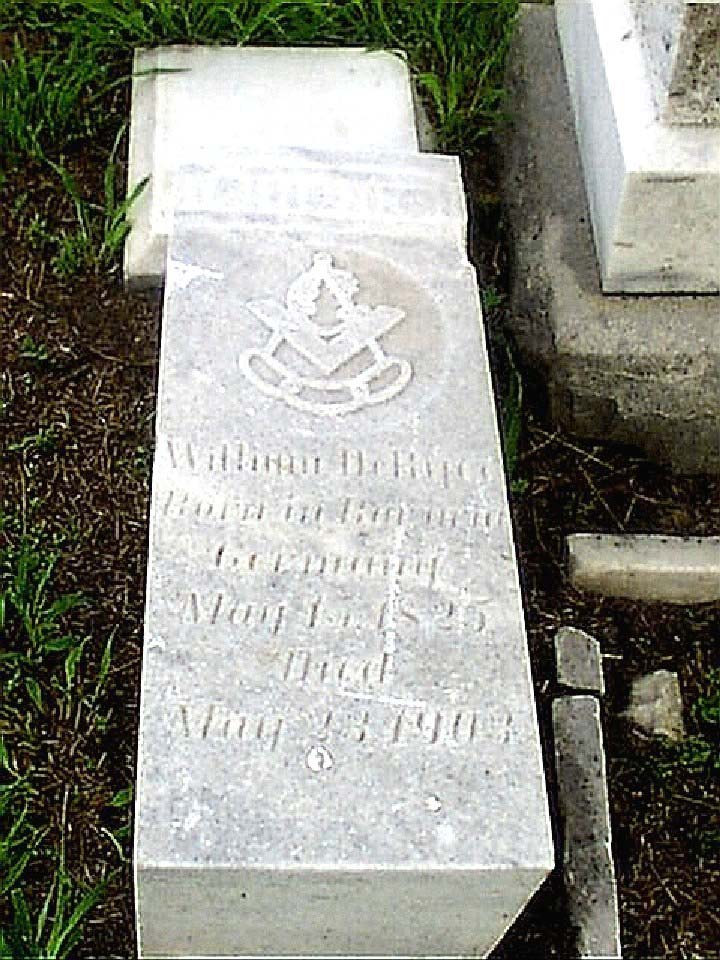William De Ryee
William De Ryee
Born in Bavaria
Germany
May 15, 1825
Died
May 23, 1903


Photo Credit: Rosa G. Gonzales
1. Corpus Christi History by Murphy Givens
Corpus Christi Caller-Times (August 16, 2000). Available on microfilm.
Source: Corpus Christi Caller, 1889
Provenance: Corpus Christi Public Libraries
4. Article or reference in The Handbook of Texas online
5. Howard Association and Yellow Fever in The Handbook of Texas Online
6. Homeograph
Provenance: Corpus Christi Public Libraries
Provenance: Corpus Christi Public Libraries
8. Reference from Pioneer Photographers from the Mississippi River to the Rocky Mountains:
A Biographical Dictionary, 1840-1865
DeRyee branched out into the field of stereopticon and magic lantern entertainment in 1859. On September 1 the San Antonio Daily Herald advertised the “last exhibition� of the “Mammoth Agioscop [sic]� that evening at the Casino Hall. Although the proprietors of this magic lantern and dissolving view show were not named, by the time the Mammoth Agioscop was exhibited in New Braunfels in September, the producers were identified as DeRyee and two partners, William C. A. Thielepape and Karl Friedrich Hermann Lungkwitz. Following a week-long engagement in New Braunfels, the show was scheduled to move on to Fredericksburg and Austin.
DeRyee, Lungkwitz and Thielepape arrived in Austin with their Agioscop in November 1859. By the following month, they had opened a “gallery of fine arts,� where they took “Photochromatypes.� Their sojourn in Austin coincided with the session of the Eighth Legislature, and during the following winter they photographed virtually every elected state official. DeRyee and another partner, R. E. Moore, published an album of these portraits, The Texas Album, of the Eighth Legislature, 1860: A Texas Enterprise by Wm. DeRyee & R. E. Moore (Austin: Printed by Miner, Lambert & Perry, 1860).
During his time in Austin, DeRyee lobbied the state legislature to adopt his method of homeography as a means of reproducing maps. On February 11, 1860, the legislature passed a law authorizing the General Land Office to either “introduce the DeRyee method of printing and multiplying maps or to establish a Photographic Bureau for the purpose of facilitating the business of the General Land Office.� DeRyee informed the Commissioner of the General Land Office that he would charge that bureau three thousand dollars for his “secret� and five hundred dollars to give instructions in the process. The commissioner declined the offer on the grounds that DeRyee did not have a patent on his process; hence, the state might become liable for patent infringement. In the end, the General Land Office authorized one of its own draftsmen, Christoph Conrad Stremme, to establish a photographic bureau in which maps were copied with a large-format camera.
Near the end of their sojourn in Austin, DeRyee, Lungkwitz and Thielepape exhibited their Magic Agioscop for “one night only� at Buaas’ Hall on February 7, 1860. It featured “Life Size Portraits of the Governors, Members of the eighth legislature, and heads of departments of Texas,� along with such vignettes as “The Shipwreck,� “Landscape: Winter Follows Autumn,� and “The Crucifixion and Transfiguration of Christ.� The same three partners owned a magic lantern extravaganza with the bombastic title Stereomonoscopic Dissolving Views and Polaroscopic Fire Works, which toured up the Mississippi and Ohio Rivers in 1860, visiting such cities as St. Louis (late July) and Madison, Indiana (early November). They may have visited Cincinnati, and they at least planned for an engagement in Wheeling from mid- to late-November. The trio stopped in Indianola upon their return to Texas in early January 1861 and gave several performances of the show, which included “a succession of pictures of Kings, Captains, Actors, Actresses, Candidates for President, Temples, Cities, Shipping, a Ship and House on fire, the Seasons coming and going, Water-falls, Snowstorms, and all the wonders of a modern dioramic display.�
Source: Kailbourn, Thomas R. and Peter E. Palmquist. Pioneer Photographers from the Mississippi River to the Rocky Mountains: A Biographical Dictionary, 1840-1865. Palo Alto: Stanford University Press, 2002.
Information courtesy of Thomas R. Kailbourn.